|
|
|
|
|
|
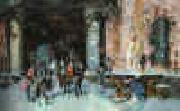 |
Mariano Fortuny y Marsal
|
|
1838-1874
Spanish
Mariano Fortuny y Marsal Gallery
He was born in Reus, a town near Taragona in the autonomous community of Catalonia in Spain. His father died when he was an infant, his mother by age 12, thus Mariano was raised by his grandfather, a cabinet-maker. His grandfather taught him to make wax figurines. At the age of 9, at a public competition in his town a local patron, Domingo Soberno, encouraged further study. At the age of 14 years he moved to Barcelona with his grandfather. A sculptor, Domingo Taleru, secured him a pension of to allow him to attend the Academy of Barcelona. There he studied for four years under Claudio Lorenzale, and in March of 1857 he gained a scholarship that entitled him to two years of studies in Rome starting in 1858. There he studied drawing and grand manner styles.
In 1859, he was called by the Spanish government to depict the campaigns of the Spanish-Moroccan War. The expedition lasted for only about six months, and he returned to Spain in the summer of 1860.
The battle of Tetuan by Mariano Fortuny (1863-73)Since the days of Velazquez, there had been a tradition in Spain of memorializing battles and victories in paint; and on the basis of his experiences, Fortuny was commissioned by the city of Barcelona to paint a large canvas diorama of the capture of the camps of Muley-el-Abbas and Muley-el-Hamed by the Spanish army. He began his composition of The battle of Tetuan on a canvas fifteen metres long; but though it worked on and off on it during the next decade, he never finished it.
The greater influence of this travel on Fortuny was his subsequent fascination with the exotic themes of the world of Morocco, painting both individuals and imagined court scenes. He visited Paris in 1868 and shortly afterwards married Cecilia de Madrazo, the daughter of Federico Madrazo, who would become curator of the Prado Museum in Madrid. Together, they had a son, Mariano Fortuny y Madrazo, who became a well-known fashion and tapestry designer. Another visit to Paris in 1870 was followed by a two years' stay at Granada, but then he returned to Rome, where he died somewhat suddenly on the 21st of November 1874 from an attack of tertian ague, or malaria , contracted while painting in the open air at Naples and Portici in the summer of 1874.
Fortuny paintings are colorful, with a vivacious iridescent brushstroke, that at times recalls the softness of Rococo painting but also anticipates impressionist brushwork, Fortuny??s recollection of Morocco is not a costume ball, but a fierce, realistic portrait which includes bare-chested warriors. Richard Muther states:
??his marvellously sensitive eye ?? discerned the stalls of Moorish carpet-sellers, with little figures swarming, and the rich display of woven stuffs of the East; the weary attitude of old Arabs sitting in the sun; the sombre, brooding faces of strange snake-charmers and magicians. This is no Parisian East??every one here speaks Arabic??.
Fortuny often painted scenes where contemporary life had still not shaken off the epaulets and decorations of ancient traditions such a the ????Burial of a matador???? and couples signing marriage contracts (La Vicaria). Each has the dazzle of bric-a-brac [1]ornament, but as in his painting of the ????Judgement of the model????, that painterly decorative air of Rococo and Romanticism was fading into academicism and left to confront the naked reality of the represented object. He inherited Goya??s eye for the paradox of ceremony and reality. |
|
|
|
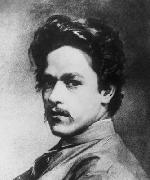 |
Nikolai Yaroshenko
|
|
(Ukrainian: Mykola Oleksandrovych Yaroshenko; Russian: December 13 [O.S. Dec. 1] 1846 in Poltava - July 7 [O.S. June 25] 1898 in Kislovodsk) was a Russian painter of Ukrainian origin.
Nikolai Alexandrovich Yaroshenko was born on December 13 [O.S. Dec. 1] 1846 in the city of Poltava, Russian Empire (now in Ukraine) to a son of a Russian Army officer. He chose a military career, but also studied art at Kramskoi's drawing school and at the Saint Petersburg Imperial Academy of Arts.
In 1876, he became a leading member of a group of Russian painters called the Peredvizhniki (also known as the Itinerants). |
|
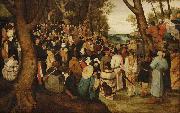 |
Pieter Brueghel the Younger
|
|
(1564 or 1565 - 10 October 1636) was a Flemish painter, known for numerous copies after his father Pieter Brueghel the Elder's paintings and nicknamed "Hell Brueghel" for his fantastic treatments of fire and grotesque imagery.
Pieter Brueghel the Younger was the oldest son of the famous sixteenth-century Netherlandish painter Pieter Brueghel the Elder (known as "Peasant Brueghel") and Mayken Coecke van Aelst. His father died in 1569, when Pieter the younger was only five years old. Then, following the death of his mother in 1578, Pieter, along with his brother Jan Brueghel the Elder ("Velvet Brueghel") and sister Marie, went to live with their grandmother Mayken Verhulst (widow of Pieter Coecke van Aelst). She was an artist in her own right, and according to Carel van Mander, possibly the first teacher of the two sons. The family moved to Antwerp sometime after 1578 and Pieter possibly entered the studio of the landscape painter Gillis van Coninxloo (1544 - 1607). In the 1584/1585 registers of Guild of Saint Luke, "Peeter Brugel" is listed as an independent master. On 5 November 1588 he married Elisabeth Goddelet, and the couple had seven children.
He painted landscapes, religious subjects and fantasy paintings. For this last category he often made use of fire and grotesque figures, leading to his nickname "Hell Brueghel".
Apart from these paintings of his own invention, Pieter Brueghel the Younger also copied the works his father had created by using a technique called pouncing. His genre paintings of peasants lack Pieter the Elder's subtlety and humanism, and emphasize the picturesque
|
|
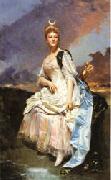 |
Raimundo de Madrazo y Garreta
|
|
Spanish realist Painter , 1841-1920
Son of Federico de Madrazo y K?ntz. Because of his ability and training with his father, Federico, in the Real Academia de S Fernando in Madrid and with L?on Cogniet in Paris, he seemed destined to continue the family tradition of academic painting. However, due to the influence of the Belgian Alfred Stevens, of his brother-in-law, Mariano Jos? Bernardo Fortuny y Marsal, and the Parisian environment, he exchanged dry historical painting (e.g. Arrival in Spain of the Body of the Apostle St James, 1858, and Ataulfo, 1860) for the preciousness of the tableautin, the small, intimate genre painting. He lived in Paris and New York and became so remote from Spanish artistic life that he and Fortuny y Marsal were the only Spanish artists not to participate in any national exhibition, and because of this the Spanish state never directly acquired their works. In 1882, with Giuseppe De Nittis, Stevens and the gallery owner Georges Petit, he co-founded the Exposition Internationale de Peinture, designed to promote foreign artists in Paris. Madrazo Garreta's most characteristic works are the female portrait and the witty and elegant genre painting, with soft, delicate tones and suggestive poses. The influence of the Rococo and of Japanese art is reflected in his painting, which expresses an exquisite aristocratic or bourgeois ideal, the illusion of a refined, sensual and superficial life. Consequently, |
|
|
|
|
|
 |
Sir edward coley burne-jones,Bt.,A.R.A.,R.W.S
|
|
1833-1898
English painter and decorative artist. He was the leading figure in the second phase of the Pre-Raphaelite movement. His paintings of subjects from medieval legend and Classical mythology and his designs for stained glass, tapestry and many other media played an important part in the Aesthetic Movement and the history of international Symbolism. |
|
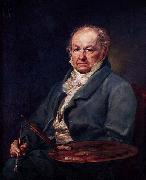 |
Vicente Lopez y Portana
|
|
(September 19, 1772, Valencia, Spain CJuly 22, 1850, Madrid, Spain) was a Spanish painter, considered the best portrait painter of his time.
Vicente Lepez y Portaña was born in Valencia on September 19, 1772. His parents were Cristebal Lepez Sanchordi and Manuela Portaña Meer. Vicente Lepez began formally studying painting in Valencia at the age of thirteen, he was a disciple of father Antonio de Villanueva, a Franciscan monk, and he studied at the Academy of San Carlos in his native city. He was seventeen when he won first prize in drawing and coloring receiving a scholarship to study in the prestigious Academia Real de Bellas Artes de San Fernando in Madrid. For the following three years in Madrid, he apprenticed with the Valencian painter, Mariano Salvador Maella. Vicente Lepez returned to Valencia in 1794 and subsequently became vice-director of painting at the Academy where he had studied as a boy. In 1795 he married Maria Piquer, they had two sons: Bernardo Lepez Piquer and Luis (1802-1865), who were also painters, following their father's style but with little accomplishments. In 1801 Lepez was named President of the Academy of San Carlos. |
|
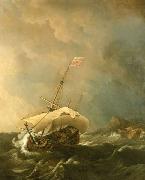 |
Willem Van de Velde The Younger
|
|
(bapt. 18 December 1633 - 6 April 1707) was a Dutch marine painter.
Willem van de Velde was baptised on 18 December 1633 in Leiden, Holland, Dutch Republic.
A son of Willem van de Velde the Elder, also a painter of sea-pieces, Willem van de Velde, the younger, was instructed by his father, and afterwards by Simon de Vlieger, a marine painter of repute at the time, and had achieved great celebrity by his art before he came to London. In 1673 he moved to England, where he was engaged by Charles II, at a salary of £100, to aid his father in "taking and making draughts of sea-fights", his part of the work being to reproduce in color the drawings of the elder van de Velde. He was also patronized by the Duke of York and by various members of the nobility.
He died on 6 April 1707 in London, England. |
|
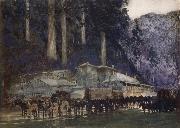 |
William Blamire Young
|
|
English Australian artist .
1862-1935
known as Blamire Young, was an English Australian artist. Young was born at Londesborough, Yorkshire, the second son of a family of 12. His father, Colonel Young, came of prosperous yeoman stock. Blamire Young was educated at the Forest School, Walthamstow, where he received a classical training, and going on to Cambridge University specialized in mathematics. That he completed his course with no better than third-class honours was no doubt partly caused by his discovery of the print collection in the Fitzwilliam Museum, and his association with the Cambridge Fine Art Society. It had been intended that he should become a clergyman, but Young felt that he had no vocation for that work and obtained the position of mathematical master at Katoomba College, Katoomba, New South Wales, which had been founded by John Walter Fletcher in 1884. Young remained at the school for eight years. In his spare time he practised painting, and meeting Phil May received some instruction from him in painting in oil. In 1893, he returned to England and after working for a few months under Hubert von Herkomer, became associated with James Pryde and William Nicholson in poster work. In 1895 Young returned to Australia and with the Lindsay brothers and Harry Weston did some excellent posters. But the field was limited and many years of poverty followed, during which a certain amount of writing was done for the press. He began exhibiting at the Victorian Artists' Society, but sales were few and the one-man show was then unknown. During his visit to England he had married Mabel Sawyer, an expert wood-carver, and while the lean period lasted Mrs Young helped to keep the house going by executing commissions for Melbourne architects. It was not until 1911 that the appreciation of Young's art really began to be shown. In that year he held an exhibition at Melbourne of small pictures, some of which had similar qualities to the Japanese coloured wood-cuts of the eighteenth century. Sales were good, partly because the prices were low, and the artist was sufficiently encouraged to hold an exhibition at Adelaide. This was both an artistic and a financial success, other shows followed in Melbourne and Sydney, and at last, in his fiftieth year, Young's reputation as an artist was established. In 1912 he sailed for Europe and after a stay in Spain settled in England. Eighteen months later in August 1914 his first show, opened at the Bailey Galleries. All the arrangements had been made and the pictures hung when war broke out. Young had been a good marksman in his youth, and for three years worked as an instructor in musketry and machine-gunnery. Immediately after the war he took up his painting again and exhibited at the Academy and the Royal Society of British Artists. Back in Australia in 1923 Young established himself at Montrose in the hills about 20 miles east of Melbourne. He acted as art critic for the The Herald and held occasional one-man shows. |
|
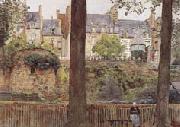 |
William Frederick Yeames,RA
|
|
1835-1918
English painter. The son of a British consul in Russia, Yeames was sent to school in Dresden after the death of his father in 1842. He also studied painting there. The collapse of the Yeames family fortune resulted in a move to London in 1848, where Yeames learnt anatomy and composition from George Scharf (1788-1860). He later took lessons from F. A. Westmacott. In 1852 he continued his artistic education in Florence under Enrico Pollastrini and Raphael Buonajuto, from whom he learnt the methods of the Old Masters. He drew from frescoes by Ghirlandaio, Gozzoli and Andrea del Sarto and painted in the Life School at the Grand Ducal Academy. He then went to Rome and made landscape studies and copied Old Masters, including Raphael's frescoes in the Vatican. His extensive study of Italian art gave him a precision and facility that assisted his artistic success upon his return to London in 1859. There he set up a studio in Park Place and became involved with the ST JOHN'S WOOD CLIQUE. He exhibited at the Royal Academy and the British Institution from 1859 and became an ARA in 1866. |
|
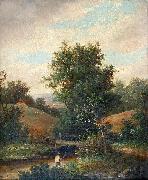 |
William Yates
|
|
painted Fisherman on the River Bank in 19th Century
|
|
|
|
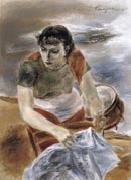 |
Yasuo Kuniyoshi
|
|
Japanese-born American Photographer, 1893-1953
was an American painter, photographer and printmaker born in Okayama, Japan. He migrated to America in 1906, a year later began studying at the Los Angeles School of Art and Design. In 1935 he was awarded the Guggenheim Fellowship. He was known for his still-life paintings of common objects, female circus performers and nudes. He died in New York City. |
|
|
|
|
|
|

